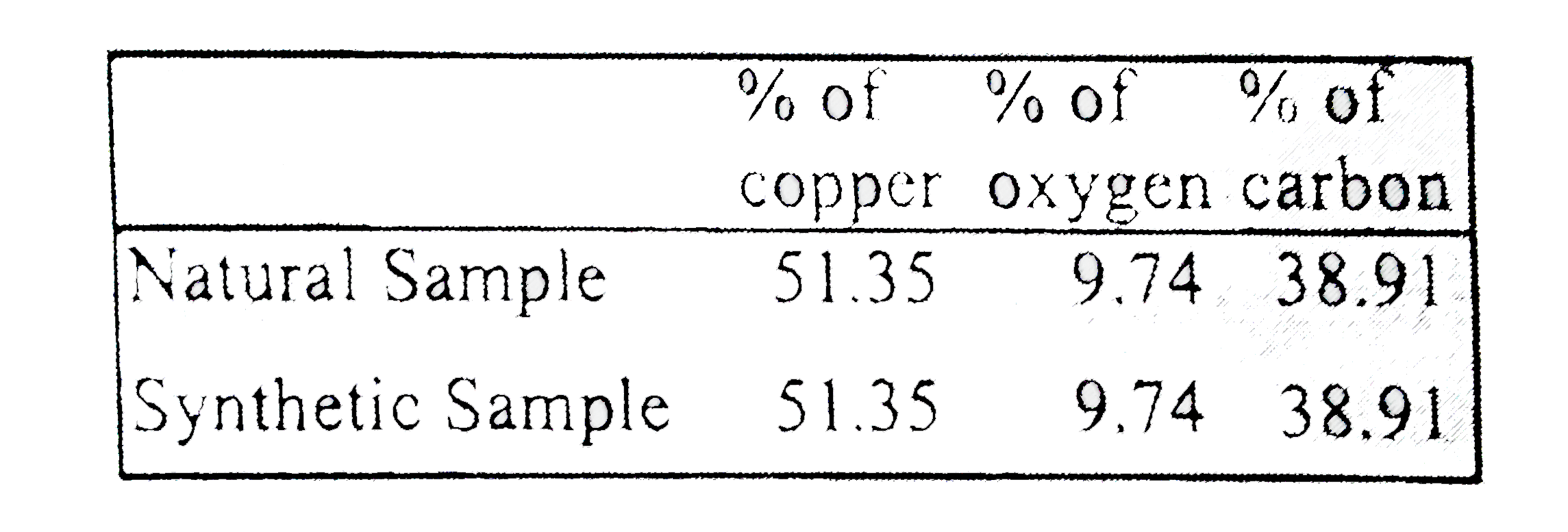This law was given by, a French chemist , Joseph Proust. He stated that a given compound always contains exactly the same proportion of elements by weight.
Proust worked with two samples of curpic carbonate- one of which was of natural origin and the other was synthetic one . He found that the composition of elements present in it was for both the samples as shown below:
Thus, irrespective of the source, a given compound always contains same elements in the same proportion. The validity of this law has been confrmed by various experiments. It is sometimes also reffered to as Law of constant composition.
Limitation:
This law is not applicable if the compound is formed from different isotopes of an element . The two isotopes of carbon C-12 and C-14 form carbondioxide C12O2 and C14O2 . The ratio of C : O is 12 : 32 and 14 : 32 respectively .It is not a constant ratio.
6.488 g lead with 1.002 g oxygen to form an oxide. This oxide is also obtained by heating Pb(NO3)2, It is found that % of lead in this oxide is 86.62 .Show that these date illustrate the law of definite proportions.

The correct Answer is:%PB=6.488+1.002(6.488+1.002)×100=86.6%
Step by step video & image solution for This law was given by, a French chemist , Joseph Proust. He stated that a given compound always contains exactly the same proportion of elements by weight. Proust worked with two samples of curpic carbonate- one of which was of natural origin and the other was synthetic one . He found that the composition of elements present in it was for both the samples as shown below: Thus, irrespective of the source, a given compound always contains same elements in the same proportion. The validity of this law has been confrmed by various experiments. It is sometimes also reffered to as Law of constant composition. Limitation: This law is not applicable if the compound is formed from different isotopes of an element . The two isotopes of carbon C-12 and C-14 form carbondioxide C^(12)O_(2) and C^(14)O_(2) . The ratio of C : O is 12 : 32 and 14 : 32 respectively .It is not a constant ratio. 6.488 g lead with 1.002 g oxygen to form an oxide. This oxide is also obtained by heating Pb(NO_(3))_(2), It is found that % of lead in this oxide is 86.62 .Show that these date illustrate the law of definite proportions. by Chemistry experts to help you in doubts & scoring excellent marks in Class 12 exams.
Updated on:21/07/2023Topper's Solved these Questions
- MOLE CONCEPTBOOK - ALLENCHAPTER - MOLE CONCEPTEXERCISE - O-I
45 Videos
- MOLE CONCEPTBOOK - ALLENCHAPTER - MOLE CONCEPTEXERCISE - O-II
11 Videos
- MOLE CONCEPTBOOK - ALLENCHAPTER - MOLE CONCEPTEXERCISE - S-I (Problems Related with Different Types of Atomic Masses & Basic Concept of Mole)
52 Videos
- METALLURGYBOOK - ALLENCHAPTER - METALLURGYEXERCISE - EXERCISE-05 [B]
26 Videos
- p-Block Element BOOK - ALLENCHAPTER - p-Block Element EXERCISE - All Questions
20 Videos
Similar Questions
This law was given by, a French chemist , Joseph Proust. He stated that a given compound always contains exactly the same proportion of elements by weight.
Proust worked with two samples of curpic carbonate- one of which was of natural origin and the other was synthetic one . He found that the composition of elements present in it was for both the samples as shown below:
Thus, irrespective of the source, a given compound always contains same elements in the same proportion. The validity of this law has been confrmed by various experiments. It is sometimes also reffered to as Law of constant composition.
Limitation:
This law is not applicable if the compound is formed from different isotopes of an element . The two isotopes of carbon C-12 and C-14 form carbondioxide C12O2 and C14O2 . The ratio of C : O is 12 : 32 and 14 : 32 respectively .It is not a constant ratio.
0.5 G silver is dissolved in excess of nitric acid. This solution is treated with excess of NaCl solution when 0.66 g AgCl is formed. One gram metallic silver wire is heated in dry Cl2 ,1.32 g AgCl is formed . Show that these data confirm the law of constant proportion.

View SolutionWhich of the following compounds contain all the carbon atoms in the same hybridisation state ?
View Solution
Knowledge Check
Which one of the compounds shown below, is not an isomer of the others ?
A B
B C
C D
D
Assertion: 12 parts by mass of carbon in CO and CO2 molecules combine with 16 and 32 parts by mass of oxygen.
Reason : A given compound always contains exactly the same proportion of elemetns by weight.
View SolutionWhich one of the following elements is present in chlorophylls?
View SolutionWhich is mismatched regarding the position of the element as given below ?
View SolutionExistence of an element in more than one form in the same physical state
View SolutionOf the following elements, which one has the same oxidation state in all of its compounds ?
View SolutionFind the sample space associated with the experiment of rolling a pair of dice (one is blue and the other red) once. Also, find the number of elements of this sample space.
View SolutionFind the sample space associated with the experiment of rolling a pair of dice (one is blue and the other red) once. Also, find the number of elements of this sample space.
View Solution
